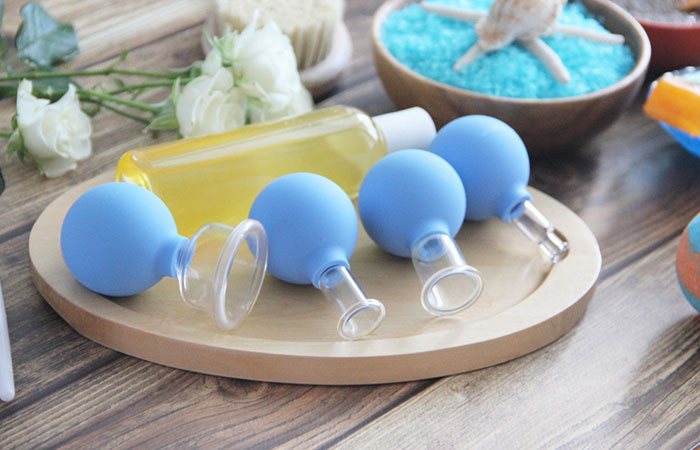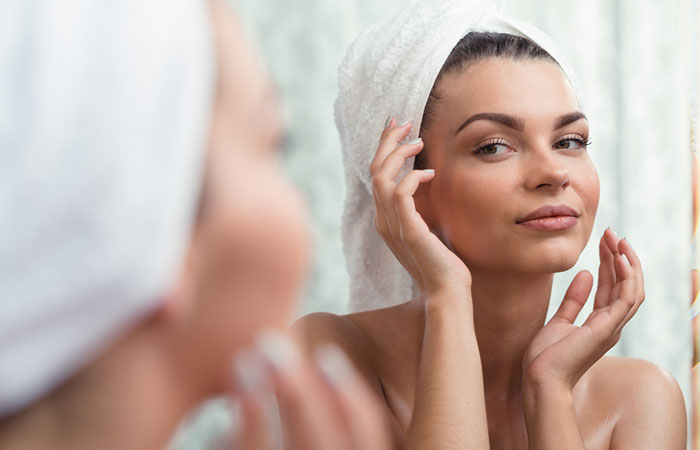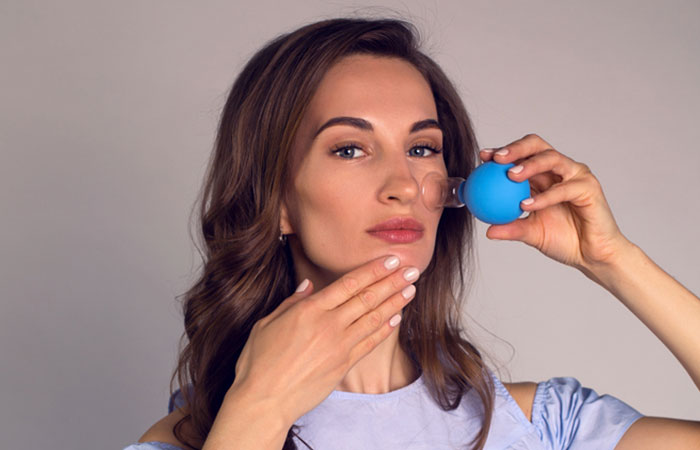Google ‘cupping,’ and you will see an array of images of backs covered in blue-black, circular bruises. Don’t be intimidated by this. That’s not what cupping is going to do to your face! Facial cupping is much milder than body cupping. This healing practice is not new to health and wellness freaks. From athletes like Michael Phelps to Hollywood A-listers like Jennifer Aniston and Gwyneth Paltrow, everyone swears by this ancient practice of healing. Facial cupping can give you healthy skin and glowing complexion (minus those polka dot-like bruises). Curious to know how? Keep scrolling.
Table Of Contents
- What Is Facial Cupping? How Is It Different From Body Cupping?
- Facial Cupping: How It Works
- Benefits Of Facial Cupping
- DIY Facial Cupping
- Potential Risks And Side Effects Of Facial Cupping
What Is Facial Cupping? How Is It Different From Body Cupping?

Shutterstock
Cupping is an ancient Chinese alternative healing practice in which the therapist uses suction cups on your skin to stimulate your muscles. It can be done both on your body and your face. People, especially athletes, use cupping for multiple purposes: to ease pain, reduce inflammation, relieve muscle tension, improve blood flow, and promote cell regeneration. It is also used as a deep tissue massage to promote relaxation and overall well-being.
The ancient Chinese believed that cupping improves the flow of positive energy or Qi (pronounced ‘chee’) throughout the body. Although this practice is linked to ancient Chinese medicine, historical evidence shows that the ancient Egyptians also used cupping therapy (1).
Both facial and body cupping follow the same principle, but the way that they are executed is different.
Facial Cupping
- It is gentler than body cupping.
- The cups that are used for facial cupping are smaller than the ones used for body cupping.
- The cups are used to pull your skin gently and rejuvenate it without leaving any marks.
- It is primarily used to improve your complexion and reduce the appearance of wrinkles and fine lines.
Body Cupping
- It is mainly used to ease aches and pains.
- It leaves behind a trail of marks that are essential for healing.
- The marks are the waste that is built up in your body. They gradually fade away as the lymphatic system processes that waste material.
The materials that are generally used to make the cups include:
- Silicone (mostly used for facial cupping)
- Bamboo
- Glass
- Earthenware
Want to know how facial cupping is done? Check out the next section to find out what to expect during a face cupping session.
Facial Cupping: How It Works

Shutterstock
The process of facial cupping is super simple. A session usually lasts for half an hour. Before the therapist starts the session, they will cleanse your skin thoroughly and apply therapeutic oils on your face, neck, and chest area and gently massage it.
They use customized cups that are usually smaller than the cups used for body cupping.
- The therapist puts the cup upside down on your face.
- The reverse suction created by the cup creates a vacuum and lifts your facial tissues.
- The therapist then moves the suction cup to produce a massage-like effect.
Facial cupping helps improve blood circulation. The massage rejuvenates the facial tissues as they receive more oxygen. This makes your skin feel fresh and healthy. There are multiple benefits of facial cupping. Check out the next section to find out what they are.
Benefits Of Facial Cupping

Shutterstock
Facial cupping therapy can:
- Ease muscle tension
- Promote collagen production by stimulating the cells responsible for it
- Strengthen facial tissues
- Improve blood and oxygen circulation to your face
These effects
- Brighten your skin
- Reduce puffiness
- Reduce the appearance of fine lines, wrinkles, and age spots
- Tone your face and neck, especially the jawline and chin areas
It is recommended you visit a professional for facial cupping as they know the proper technique. However, you can also try it at home using DIY facial cupping kits.
DIY Facial Cupping

Shutterstock
Before you start facial cupping, clean your face with a mild cleanser. Then, apply jojoba oil (or any other oil of your choice) on your face. Gently massage to spread it evenly all over your face and neck area. Follow the steps given below:
- Pick up the suction cup, press it gently and place it on your face to create a vacuum.
- Once you feel the pull on your skin, glide it gently from the center of your face towards your ears.
- Always start from the center of your face and glide the cup outwards.
- Use the smaller cups in the kit to massage the eyebrow area, nose, and T-zone. Use the bigger ones to massage your forehead, jaw, and cheeks.
- Do this for 5-10 minutes.
Do facial cupping at least 2-3 times a week to reap its benefits.
Facial cupping is considered to be a safe procedure. However, you might experience some minor side effects. These potential risks and side effects are discussed below.
Potential Risks And Side Effects Of Facial Cupping

Shutterstock
Temporary side effects of facial cupping include:
- Nausea
- Dizziness
- Lightheadedness
- Cold sweats
Avoid doing facial cupping on broken skin or if you have active breakouts or rashes on your skin.
Facial cupping is an excellent way to boost your skin’s radiance. However, going to a professional is better if you are trying it for the first time. If you want to try it at home, first practice on your arms and legs to figure out how much pressure you need to apply on your skin. Do you have any more questions about this amazing skin therapy? Drop them in the comments section below, and we’ll get back to you.
References
- “History of cupping…”, Journal of Integrative Medicine, US National Library of Medicine.
The post Facial Cupping: How It Works, Benefits, And Side Effects appeared first on STYLECRAZE.
0 Comments